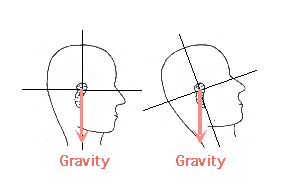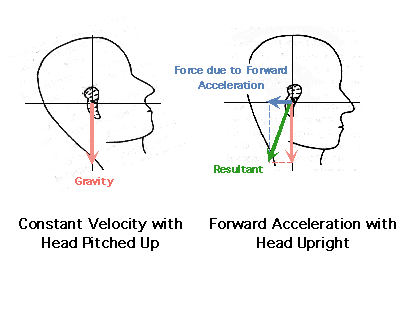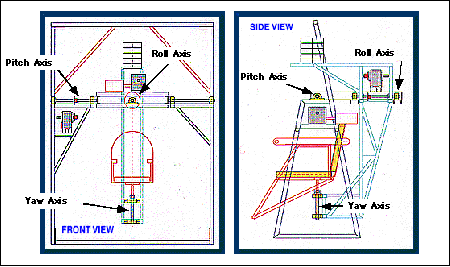
background
The somatogravic illusion is an illusion of pitch. To understand it, we need first to consider the workings of the otolith organs which are part of the vestibular apparatus (the inner ear). The main function of the otoliths is to signal the orientation of the head relative to gravity. With the head in a normal upright posture, the otoliths signal that the gravitational force is downward on the head. When the head is pitched up (e.g., when you look up), the otoliths signal that the gravitational force is oblique to the head. The head-upright and head-pitched situations are depicted in the figure below.

the effect of forward acceleration
The otoliths are also influenced by linear acceleration such as occurs when a high-performance aircraft takes off. Like gravity, linear acceleration acts on the otoliths; with forward acceleration, the apparent force is backward on the head. From the standpoint of the otoliths, the combined effect of gravity and linear forward acceleration is very similar to the effect of pitching the head upward when the pilot is not accelerating. In both cases, the apparent force is oblique to the head as shown in the figure below. For this reason, signals coming from the otoliths are ambiguous - the pilot could be accelerating forward with the head upright relative to gravity or could be at constant velocity with the head pitched up. Visual information, such as the orientation of the horizon, can and does resolve the ambiguity. However, when the horizon isn't visible, such as in a low-visibility or night takeoff, pilots frequently experience a compelling upward pitch of the head and the aircraft. This is the somatogravic or "pitch-up" illusion. Consciously or subconsciously, the pilot applies forward stick to "correct" the perceived nose-high attitude. This compounds the problem by allowing the aircraft to accelerate even more thereby accentuating the illusion. If the illusion is not recognized, or attenuated by the emergence of clear visual information, the pilot can "correct" his way right into the ground.

tilt chair
With support from the Air Force Office of Scientific Research, we are examining the properties of visual information required to override the somatogravic and related illusions. To do the work, we need to produce well-specified vestibular and somesthetic stimuli. The tilt chair, designed and constructed at Berkeley, is used for this purpose. The schematic below has a front view on the left and side view on the right. The chair rotates smoothly up to ±22° about the roll, yaw, and pitch axes. Observers' heads are stabilized by an adjustable helmet affixed to the chair. The observer's position is adjustable such that the rotations occur about the midpoint between the two eyes; thus, the midpoint between the eyes would be at the intersection of the three rotation axes shown in the figure below. Chair rotations occur in two modes, one with a joystick manipulated by the observer and the other under direct computer control. The visual stimuli are presented on a 4-ft by 3-ft projection screen illuminated by a Boxlight projection display. The screen and projector are affixed to the chair assembly so they rotate with the observer. We can create the otolith signals that occur during the takeoff of high-performance aircraft by rotating the chair about the pitch axis (clockwise in the side view below).





